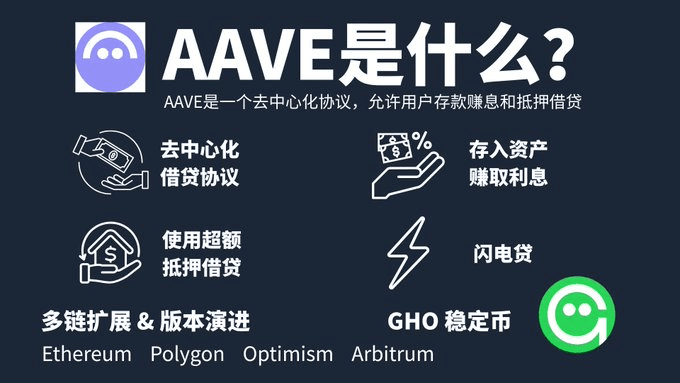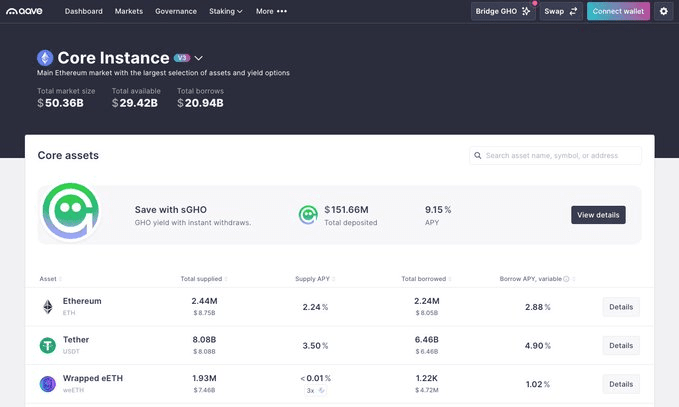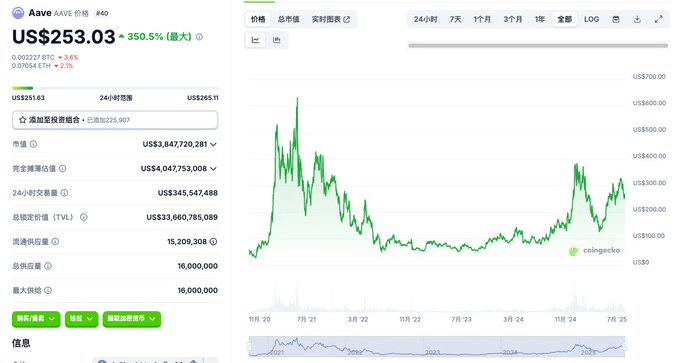Today, let's talk about the OG in DeFi lending: Aave

💸 What is Aave?
Aave is a decentralized lending protocol based on Ethereum; you can think of it as a fully automated, open-source 'cryptocurrency bank' or 'capital market' built on blockchain, allowing you to deposit and earn interest, and borrow against collateral without intermediaries.
Simply put:
Those with spare cash → Deposit it to earn interest
Those who want to borrow money → Collateralize assets to borrow
It's like a bank for DeFi, but completely decentralized, code-executed, and asset self-custodied.

🛠️ How does Aave work?
1. Depositor (Lender / Supplier)
What to do? Users can deposit their idle cryptocurrencies (like ETH, USDC, DAI, etc.) into AAVE's 'Liquidity Pool'.
Why do this? In return, depositors can earn interest. This interest is variable, dynamically determined by the market demand for that asset. The higher the demand, the higher the interest rate.
How does it work? When you deposit assets, the protocol provides you with a certificate called aToken (for example, depositing USDC will yield aUSDC). This aToken represents your share in the liquidity pool and will automatically appreciate, with interest accumulating this way. You can always exchange aToken for the assets you initially deposited along with the earned interest.
2. Borrower
What to do? Users can borrow the cryptocurrencies they need from the liquidity pool.
Why do this? For example, if you are bullish on Ethereum (ETH) in the long term but need a stablecoin (like USDC) for consumption or investment in the short term, and you do not want to sell your ETH. In this case, you can deposit your ETH as collateral in AAVE and then borrow USDC.
How does it work? Borrowing must be over-collateralized. This means that the value of the collateralized assets must be greater than the value of the borrowed assets.
Example: If you want to borrow $100 worth of USDC, you might need to collateralize with $150 worth of ETH. The extra $50 is the safety cushion.
Liquidation Risk: If the price of your collateral (ETH) drops, causing the collateralization ratio to fall below a certain safety threshold (for example, 110%), your collateral will be automatically sold by the system (i.e., 'liquidated') to repay your debt, ensuring the safety of depositors' funds.
📌 The core mechanism is over-collateralized lending:
If you want to borrow $100 USDC, you must collateralize with crypto assets worth more than that amount, such as $150 worth of ETH.
🧠 What are the highlighted features?
Flash Loans: Borrow without collateral, but must repay within the same transaction. Suitable for arbitrage, liquidation, re-collateralization, and other complex operations. This feature once became very popular in DeFi.
aToken: Represents your deposit assets + real-time interest earnings (automatically grows). It can also be transferred and traded like other tokens, having strong composability.
Interest rate strategy: Choose fixed rate or variable rate.
Strong composability: Aave is a fundamental component for many other DeFi projects, such as Yearn and Instadapp, both of which integrate it.
🌍 Multi-chain expansion & version evolution
Aave is no longer just on Ethereum:
✅ Ethereum Mainnet
✅ Polygon
✅ Optimism
✅ Arbitrum
✅ Avalanche
✅ Base
✅ BNB Chain (in testing)
It is one of the few DeFi protocols that has truly achieved multi-chain deployment and cross-chain scalability.
Additionally, Aave continues to upgrade versions:
V1 → V2: Supports more complex operations (flash repayment, collateral switching, etc.)
V2 → V3: Introduced efficient models, cross-chain assets, risk isolation, and other new mechanisms
💰 What is the role of AAVE tokens?
AAVE is the platform's native governance token, with functions including:
Governance: Participate in protocol proposals and voting
Security Module: AAVE can be staked to protect the protocol's security (compensation in case of black swan events)
Discount: Staking AAVE can earn interest rate discounts in lending
Latest development: GHO stablecoin
AAVE launched its own decentralized, over-collateralized stablecoin GHO. Users can use their diverse collateral deposited in the AAVE protocol to mint (borrow) GHO, further enhancing the liquidity of their collateral assets.

📊 Why is Aave important?
1. TVL has always been the TOP 1/2 in the DeFi lending sector
2. Flash Loans + multi-chain layout, highly innovative
3. aToken model drives on-chain yield standardization
4. High security record, no major hacking incidents to date
🧱 Summary: What role does Aave play?
Aave is like the 'J.P. Morgan' of DeFi:
Robust, large scale
Complete product offerings, technological innovation
A cornerstone project in DeFi lending and composable finance (Money Lego)
If you want to understand lending strategies, stable returns, and automatic profit in DeFi, Aave is an essential OG project. Especially the design of Flash Loan, which remains unmatched.
Which protocol should we discuss next? Feel free to leave comments below 👇
📌 If you like this kind of content, please like + share + follow, and don't miss the next issue!